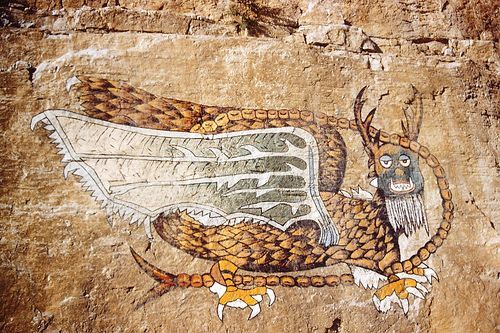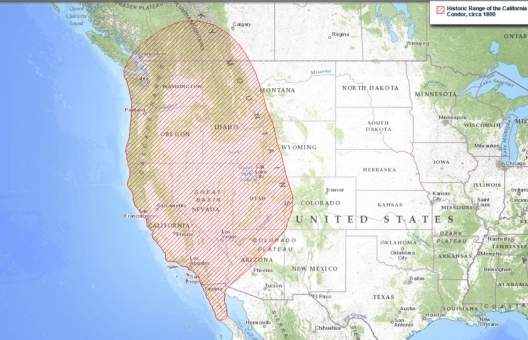The Piasa Bird

Thousands of ancient pictographs are carved or painted on rocks along the Mississippi River between Illinois and Missouri. For hundreds of years, explorers have described these images, townspeople whispered about them, and archeologists recorded their findings. The most curious image is that of the Piasa.
The Piasa is a creature from Native American mythology depicted in two murals along the limestone bluffs in Madison County, Illinois. The original illustration has long since weathered away, but a new version has replaced it based on 19th-century sketches.
The sketch depicts a creature called the Piasa. It is supposedly as large as a calf, but had antlers and red eyes and scales or feathers covering the body as well as a tail that could completely wrap around its body. The original descriptions of the cave painting make no mention of wings, but modern depictions show the creature sporting large wings and it is often referred to as a “Piasa Bird.”
So what inspired this painting?
 1934 restoration of the Piasa
1934 restoration of the PiasaThe first European record of the Piasa comes from Father Jacques Marquette during his 1673 journey down the Mississippi River with Louis Jolliet. He described the painting on the bluffs near modern-day Alton, IL. However, he found it difficult to believe it was painted by the Indigenous people of the area. He did not believe even the most talented French painters would have been about to complete the work. Neither his nor Jolliet’s journal of the expedition made any mention of the pictograph’s significance and his original sketch did not survive.
It was not until John Russell moved to Illinois in the 1830’s that interest was once more sparked by those of European descent. He wrote in several Illinois papers of a winged demon that terrorized the native peoples of the region. He called it the “Piasa” – which Russell claimed was an Illini word meaning “the bird that devours men.” He stated the creature could carry off deer in its talons, but once it tasted human flesh it would eat nothing else. Entire villages were destroyed and the Illini realized the Piasa must be destroyed.
Russell went on to claim that an Illini chief prayed to the Great Spirit for guidance. The chief was directed to select twenty of his best warriors. The chief acted as live bait. As the bird swooped down to seize the chief, the warriors emerged and shot the beast. The painting was to commemorate the victory.
 1999 restoration of the Piasa
1999 restoration of the PiasaModern scholars believe that Russell’s story was mostly fabricated, drawing on a number of sources including the 1833 autobiography of Black Hawk. In this autobiography, Black Hawk reminisced about living on Diamond Island where a spirit lived in a cave in the rocks. This spirit was a giant creature with large wings like a swan. Russell also changed his story several times over the years, further leading scholars to believe it was fabricated.
So what could have inspired the original drawing?

Some scholars believe the Piasa is based on the Califonia condor. The California Condor is the largest North American land bird. Its plumage is black with patches of white and has a bald head with yellow or orange skin. The bird’s wingspan is the widest of any North American bird reaching up to 3.0 m and weighing up to 12 kg. The condor is mainly a scavenger and eats carrion.
Looking at the Califonia Condor, it may be surprising to see how the animal could be mistaken for the animal painted on the cliff face. It may also be surprising to think about this now coastal animal being spotted in the central United States.
 Condor range in 1800s
Condor range in 1800sIn 1987, all wild condors became extinct. The species only survived in captivity. This species declined dramatically – along with Bald and Golden Eagles – due to the use of an agricultural chemical (DDT) that weakened their eggshells. This prevented their population from replenishing itself. The populations further declined due to poaching and habitat destruction. These animals were put on the critically endangered list. Since the condor population had grown from 27 to 537 as of December 2022.
However, the condor population has not always so diminished. When European settlers came to the western United States, condors could be found across the Rocky Mountain region. Researchers believe the Piasa painting dates back to AD 1000 to 1500, much earlier than range maps exist for.
This species covered North America during the Ice Age. California condor bones can be seen even down in southern Florida. It was not until the extinction of the Ice Age megafauna and American westward expansion that pushed the condors to small range they live today. It is highly likely the condors would have still been present in Illinois when the Piasa was painted.

Condors evolved during the Pleistocene Epoch. As the climate changed, the California Condor became the only remaining member of its family. They evolved to eat the large megafauna that is extinct today (i.e. mammoths, rhinos, camels, etc.). Today, they still prefer to feast on large, terrestrial mammalian carcasses such as deer, goats, horses, cougars, bears, or cattle. It was widely thought that they would scavenge most of their food, however, condors prefer a fresh kill. They do not have a well-developed sense of smell, so scavenging is done by sight and when necessary.
Their size is advantageous when taking down prey or intimidating scavengers away from a carcass. It is possible that the Piasa was inspired when someone saw a condor fighting with another predator over a deer carcass or something similar.

The Piasa painting requires frequent maintenance. The people of Alton take great care to ensure the care of their mysterious creature. Visitors can walk up to the painting and read the historical markers explaining its history. The local high school has even taken the creature as their mascot.
As for the California Condor, this creature also requires constant maintenance. Their conservation project may be one of the most expensive projects in US history, costing over $35 million since WWII. If you are interested in learning more about helping the condor, click here.
Sources:
“California Condor Life History”. Ventana Wildlife Society. Archived from the original on July 30, 2007.
Dunphy, J. J. (2021, December 17). The Piasa Bird: More fiction than fact. Medium. Retrieved March 19, 2023, from https://johnjdunphy.medium.com/the-piasa-bird-more-fiction-than-fact-208dff9f669
Great Rivers and Routes. (n.d.). Piasa Bird. Great Rivers & Routes. Retrieved March 19, 2023, from https://www.riversandroutes.com/directory/piasa-bird/
Helping the California Condor. Audubon California. (2015, July 3). Retrieved March 19, 2023, from https://ca.audubon.org/helping-california-condor
Kirby, D. (n.d.). The Piasa Bird, Alton, Illinois. RoadsideAmerica.com. Retrieved March 19, 2023, from https://www.roadsideamerica.com/story/12165
Nielsen, John (2006). Condor: To the Brink and Back—The Life and Times of One Giant Bird. New York: Harper Perennial.
Snyder, Noel; Snyder, Helen (2000). The California Condor. Academic Press.
Sorrell, G. (2014, June 29). The tradition of the Piasa and the mysterious rock art of the Mississippi. Ancient Origins Reconstructing the story of humanity’s past. Retrieved March 19, 2023, from https://www.ancient-origins.net/myths-legends/tradition-piasa-and-mysterious-rock-art-mississippi-001452
Wagner, M. J. (n.d.). Piasa Bird. Mythic Mississippi project. Retrieved March 19, 2023, from https://mythicmississippi.illinois.edu/native-illinois/piasa-bird/



